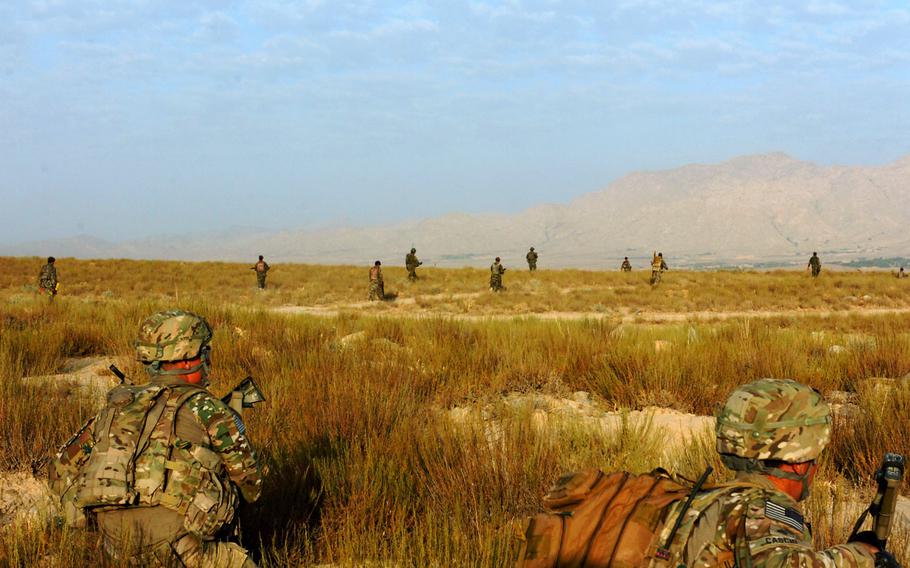
Two soldiers from 2nd Platoon, Battle Company, 2nd Battalion, 503rd Infantry Regiment, Task Force 173rd Airborne Brigade Combat Team, pull security while the soldiers of Weapons Company, 3rd Kandak, 201st Corps, Afghan National Army move toward the village of Salar in Afghanistan's Wardak province, during Operation Assaly II July 24, 2012. (Michael Sword/U.S. Army)
An agreement reached Wednesday between the NATO-led coalition and the Afghan government to withdraw from Wardak province, as President Hamid Karzai demanded could mark a tipping point for Special Forces operations in the country, according to analysts.
The coalition announced that U.S. Gen. Joseph Dunford, commander of the International Security Assistance Force, had finalized the agreement in a meeting with Karzai, who had ordered U.S. special operations forces out of Wardak province following reports of abuses by Afghans working with the U.S. troops, which coalition officials have denied.
According to an ISAF news release, coalition forces and Afghan Local Police will be replaced by Afghan National Security Forces on a schedule “determined by the Afghan Government,” starting with Nerkh District.
An Afghan Defense Ministry spokesman told a news conference in Kabul that the Afghan army was prepared to replace coalition forces, The Associated Press reported.
Douglas Ollivant, a senior fellow with the New America Foundation, said the protests against special operations forces are virulent enough and the withdrawal of international combat forces next year close enough that Afghan politicians have to impose their sovereignty.
“My sense is that it’s reached a culminating point,” he said. “The anger and the frustration and the lack of being heard have gone on for so long that the Afghan politicians have to react.”
What is less certain, Ollivant said, is whether ISAF can shut down the ALP units now operating in Wardak - located just west of Kabul.
The ALP is the fruit of ISAF efforts to recruit local civilians to fight the Taliban. Karzai has publicly complained that the ALP constitutes an extra-military force outside of his control, and civilians have accused ALP members of atrocities.
Now that ALP members are armed and organized, Ollivant said, it may be difficult for ISAF to shut them down, and, since they are locals, almost impossible to move them out of the area.
“ISAF can look at them and say ‘That’s not ALP anymore,’” he said, but can’t necessarily disband them. “What [is ISAF] going to do if [ALP members] want to stay there? Arrest them? Detain them? Shoot them?”
Michael Chalmers, a professor of defense and foreign policy at King’s College in London, pointed out that the ALP units may still exist and operate, but without American support, they’ll be considered illegal, putting them in a very different position.
He predicted that the agreement on Wardak is a harbinger of more political wrangling to come as the Afghan election approaches in 2014. America’s wish for an honorable withdrawal will have to contend with Karzai’s desire to see whoever he picks as his successor elected.
“You’ll have to reach a lot of these security decisions through the lens of domestic politics,” Chalmers said.
Ollivant said the matter is far from settled.
“It’s Afghan politics,” he said. “Everything is provisional. Everything can be renegotiated.”